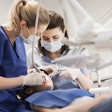Infectious diseases can be transmitted by sneezing, touching, or biting, a habit that may have driven dinosaurs to extinction through the transmission of a protozoan parasite.
Jacqueline Upcroft, a member of f1000 Biology, highlights the paleobiological detective work of David Varricchio and colleagues published in PLoS One (published online Sept. 30, 2009, doi:10.1371/journal.pone.0007288). This led them to deduce that a protozoan parasite was to blame for the diseased jaw bones seen in many tyrannosaurid fossils.
The parasite's modern-day equivalent, which infects birds, eats away at the jawbone and can cause ulcers so severe that the host starves to death. Living in the jaw, the parasite may have been passed from one dinosaur to another during head biting.
"This organism commonly infects doves, pigeons, turkeys, and raptors, causing necrotic ulceration in the upper digestive tract," Upcroft noted. In extreme cases it can fully penetrate the bone.
The similarity of the fossilized jawbones and modern-day samples suggests that the parasite was deadly enough to kill infected dinosaurs. Furthermore, Upcroft said, "this may not have been an isolated situation but may have occurred en masse and led to the extinction of the species."















